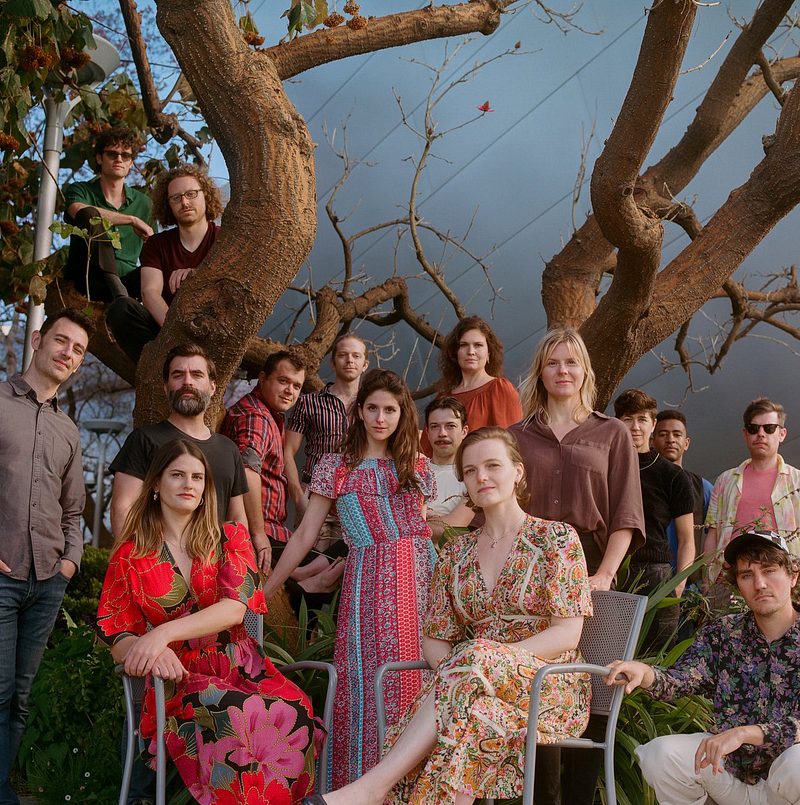
Contemporaneous has over 100 works in varying scales of artistic scope. Photo courtesy of Contemporaneous
On Saturday, April 6, Contemporaneous Ensemble graced Hamilton College with a moving performance. Nine of the original 23 member ensemble played, with a variety of instruments including a string section of cello, violin, viola and bass; a wind section of flute and clarinet; and the addition of piano and percussion. The performance was carefully modernized from the formal, black-and-white standard of most concerts. Instead, each member complemented one another in tones of red, blue and green, and most were using iPads to present their sheet music rather than sheets of paper. Almost every instrument was played solo, allowing each member’s talent to soar. Even as the sounds meshed together perfectly, one could still pick out each instrument from the audience. The ensemble was founded in New York at Bard College by the conductor, David Bloom, and composer Dylan Mattingly in 2010. The ensemble has performed at schools and institutions all over the United States.
The audience for Saturday’s performance was a mix of Hamiltonians and Clinton residents. Each song flowed smoothly, creating a ripple effect of emotion from the musicians to the audience. The ensemble covered a wide variety of sounds in their performance, from the light and calm tones of the first song to the fast and chaotic vibe of the third. There were seven songs in total, each adding something new to the overall performance, whether that be a different combination of instruments or the addition of voices to the mix of sounds. One theme rang true for every song, though: each relayed an entire story that was clear from start to finish and was rooted in a specific cultural context. For example, the first song had roots in “The Gambia in Africa,” which the conductor explained was an ensemble project designed to bring in songs from all around the world that would inspire new and creative performances. He also explained that the ensemble works closely with composers, receiving instructions and suggestions for how to perform the piece but are also able to add in their own interpretations and ideas to make the concert unique.
Another distinctive aspect of Contemporaneous’ performance was that each song was very true to its title. The audience was able to follow the story completely, and by the end, one completely understood the journey that the song laid out. For instance, the second song, “Form the Fabric” by inti Figgis-vizueta, had a clear buildup of playful, vivacious notes with separate parts from each section noticeably coming together to create something much like one does with fabric. The stage was constantly in motion, from the journey that each song took to the movement of musicians going on and off stage to the bodies of the players as they swayed with the beat, perfectly in tune with the sounds they were generating.
The ensemble has expanded in outreach and projects in the past few years with their podcast, Imagination Radio, which discusses the significance of music in their everyday lives through dialogues with “composers, scientists, a cartographer, and a BASE jumper.” Additionally, their program, Contemporaneous IMAGINATION, allows them to take on large-scale works and more grandiose projects. They also lead “a participatory program for public school students” with the hopes of “[instilling] a passion for new music” and an appreciation for “careful listening and meaningful expression through [sound].” Contemporaneous states that their mission is to “provide composers with the opportunity to take risks and to challenge themselves,” “to present…exciting music…[and] innovative performances” and “to bring educational and outreach programs to communities in need.” The excitement and passion for what they do was palpable in every performer on stage. From the appreciative clapping by the audience and obvious awe during the performance, it is clear that this ensemble has accomplished their goals.